Financial Decision Making
VerifiedAdded on 2023/01/16
|15
|4512
|37
AI Summary
This study focuses on industry analysis, business performance analysis, investment appraisal, and sources of finance in the UK coffee house industry. It includes a review of key players, challenges, and opportunities. The study also analyzes the income statement, balance sheet, and cash flow statements of Roast Ltd. for a comprehensive understanding of its financial performance.
Contribute Materials
Your contribution can guide someone’s learning journey. Share your
documents today.
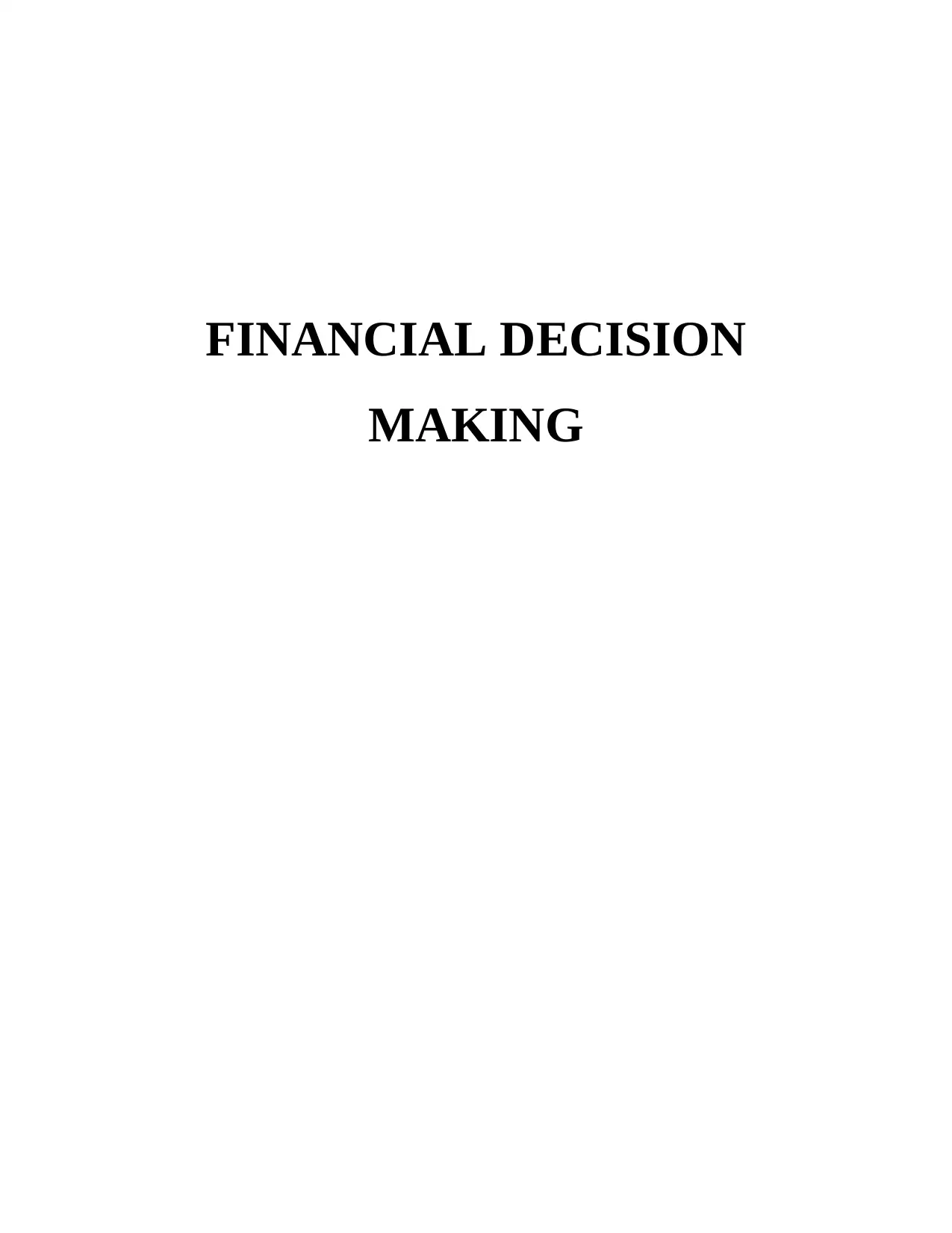
FINANCIAL DECISION
MAKING
MAKING
Secure Best Marks with AI Grader
Need help grading? Try our AI Grader for instant feedback on your assignments.
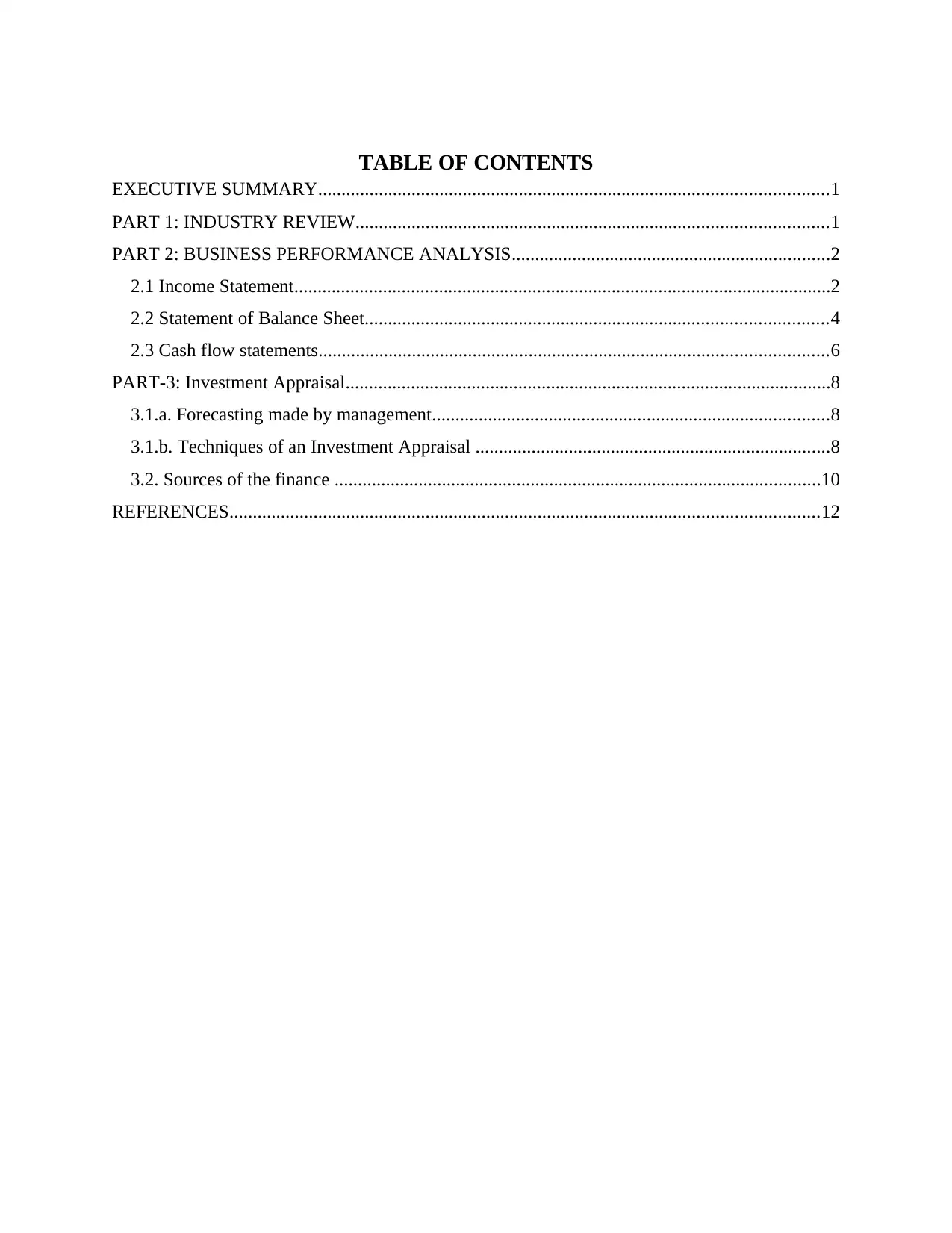
TABLE OF CONTENTS
EXECUTIVE SUMMARY.............................................................................................................1
PART 1: INDUSTRY REVIEW.....................................................................................................1
PART 2: BUSINESS PERFORMANCE ANALYSIS....................................................................2
2.1 Income Statement...................................................................................................................2
2.2 Statement of Balance Sheet...................................................................................................4
2.3 Cash flow statements.............................................................................................................6
PART-3: Investment Appraisal........................................................................................................8
3.1.a. Forecasting made by management.....................................................................................8
3.1.b. Techniques of an Investment Appraisal ............................................................................8
3.2. Sources of the finance ........................................................................................................10
REFERENCES..............................................................................................................................12
EXECUTIVE SUMMARY.............................................................................................................1
PART 1: INDUSTRY REVIEW.....................................................................................................1
PART 2: BUSINESS PERFORMANCE ANALYSIS....................................................................2
2.1 Income Statement...................................................................................................................2
2.2 Statement of Balance Sheet...................................................................................................4
2.3 Cash flow statements.............................................................................................................6
PART-3: Investment Appraisal........................................................................................................8
3.1.a. Forecasting made by management.....................................................................................8
3.1.b. Techniques of an Investment Appraisal ............................................................................8
3.2. Sources of the finance ........................................................................................................10
REFERENCES..............................................................................................................................12
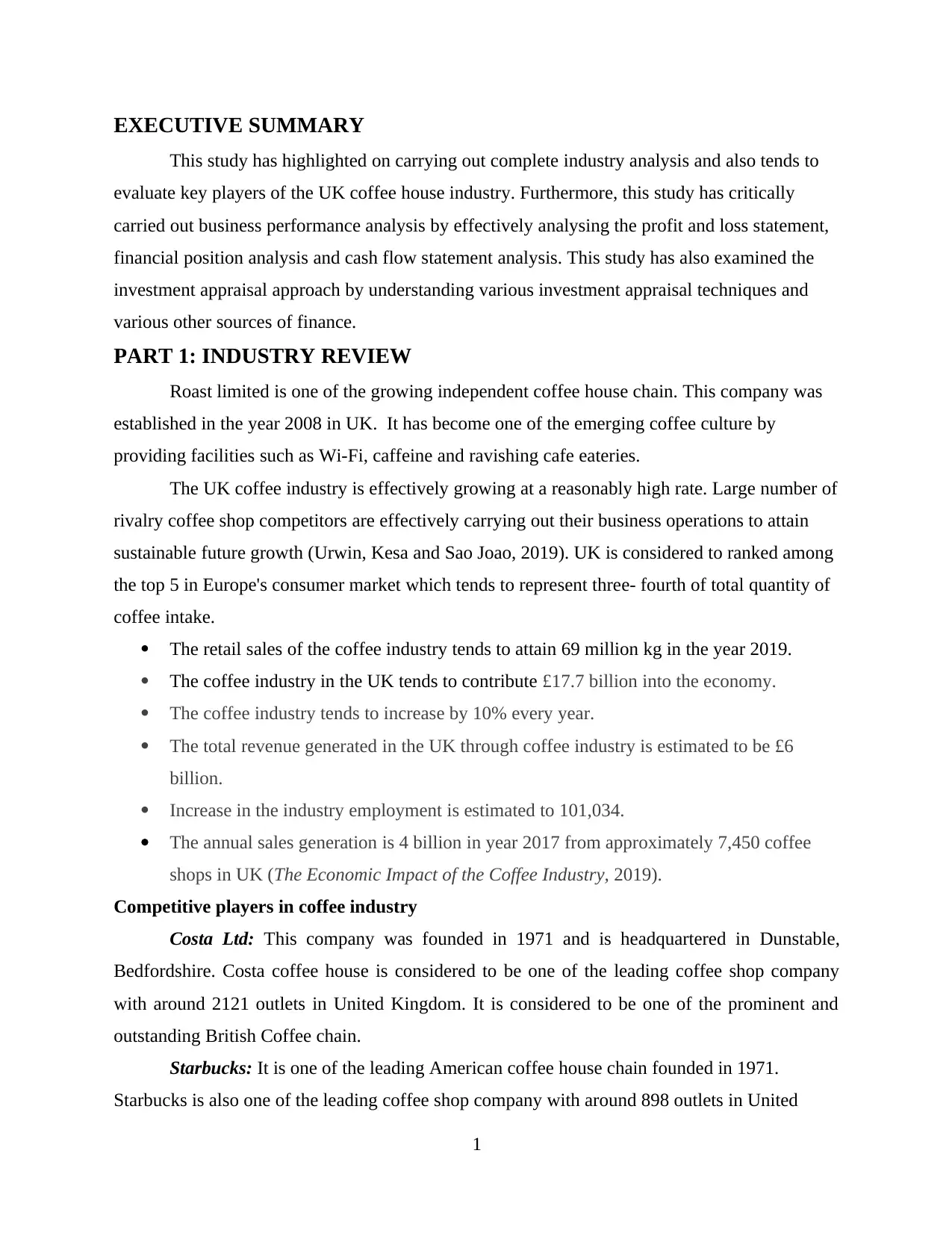
EXECUTIVE SUMMARY
This study has highlighted on carrying out complete industry analysis and also tends to
evaluate key players of the UK coffee house industry. Furthermore, this study has critically
carried out business performance analysis by effectively analysing the profit and loss statement,
financial position analysis and cash flow statement analysis. This study has also examined the
investment appraisal approach by understanding various investment appraisal techniques and
various other sources of finance.
PART 1: INDUSTRY REVIEW
Roast limited is one of the growing independent coffee house chain. This company was
established in the year 2008 in UK. It has become one of the emerging coffee culture by
providing facilities such as Wi-Fi, caffeine and ravishing cafe eateries.
The UK coffee industry is effectively growing at a reasonably high rate. Large number of
rivalry coffee shop competitors are effectively carrying out their business operations to attain
sustainable future growth (Urwin, Kesa and Sao Joao, 2019). UK is considered to ranked among
the top 5 in Europe's consumer market which tends to represent three- fourth of total quantity of
coffee intake.
The retail sales of the coffee industry tends to attain 69 million kg in the year 2019.
The coffee industry in the UK tends to contribute £17.7 billion into the economy.
The coffee industry tends to increase by 10% every year.
The total revenue generated in the UK through coffee industry is estimated to be £6
billion.
Increase in the industry employment is estimated to 101,034.
The annual sales generation is 4 billion in year 2017 from approximately 7,450 coffee
shops in UK (The Economic Impact of the Coffee Industry, 2019).
Competitive players in coffee industry
Costa Ltd: This company was founded in 1971 and is headquartered in Dunstable,
Bedfordshire. Costa coffee house is considered to be one of the leading coffee shop company
with around 2121 outlets in United Kingdom. It is considered to be one of the prominent and
outstanding British Coffee chain.
Starbucks: It is one of the leading American coffee house chain founded in 1971.
Starbucks is also one of the leading coffee shop company with around 898 outlets in United
1
This study has highlighted on carrying out complete industry analysis and also tends to
evaluate key players of the UK coffee house industry. Furthermore, this study has critically
carried out business performance analysis by effectively analysing the profit and loss statement,
financial position analysis and cash flow statement analysis. This study has also examined the
investment appraisal approach by understanding various investment appraisal techniques and
various other sources of finance.
PART 1: INDUSTRY REVIEW
Roast limited is one of the growing independent coffee house chain. This company was
established in the year 2008 in UK. It has become one of the emerging coffee culture by
providing facilities such as Wi-Fi, caffeine and ravishing cafe eateries.
The UK coffee industry is effectively growing at a reasonably high rate. Large number of
rivalry coffee shop competitors are effectively carrying out their business operations to attain
sustainable future growth (Urwin, Kesa and Sao Joao, 2019). UK is considered to ranked among
the top 5 in Europe's consumer market which tends to represent three- fourth of total quantity of
coffee intake.
The retail sales of the coffee industry tends to attain 69 million kg in the year 2019.
The coffee industry in the UK tends to contribute £17.7 billion into the economy.
The coffee industry tends to increase by 10% every year.
The total revenue generated in the UK through coffee industry is estimated to be £6
billion.
Increase in the industry employment is estimated to 101,034.
The annual sales generation is 4 billion in year 2017 from approximately 7,450 coffee
shops in UK (The Economic Impact of the Coffee Industry, 2019).
Competitive players in coffee industry
Costa Ltd: This company was founded in 1971 and is headquartered in Dunstable,
Bedfordshire. Costa coffee house is considered to be one of the leading coffee shop company
with around 2121 outlets in United Kingdom. It is considered to be one of the prominent and
outstanding British Coffee chain.
Starbucks: It is one of the leading American coffee house chain founded in 1971.
Starbucks is also one of the leading coffee shop company with around 898 outlets in United
1
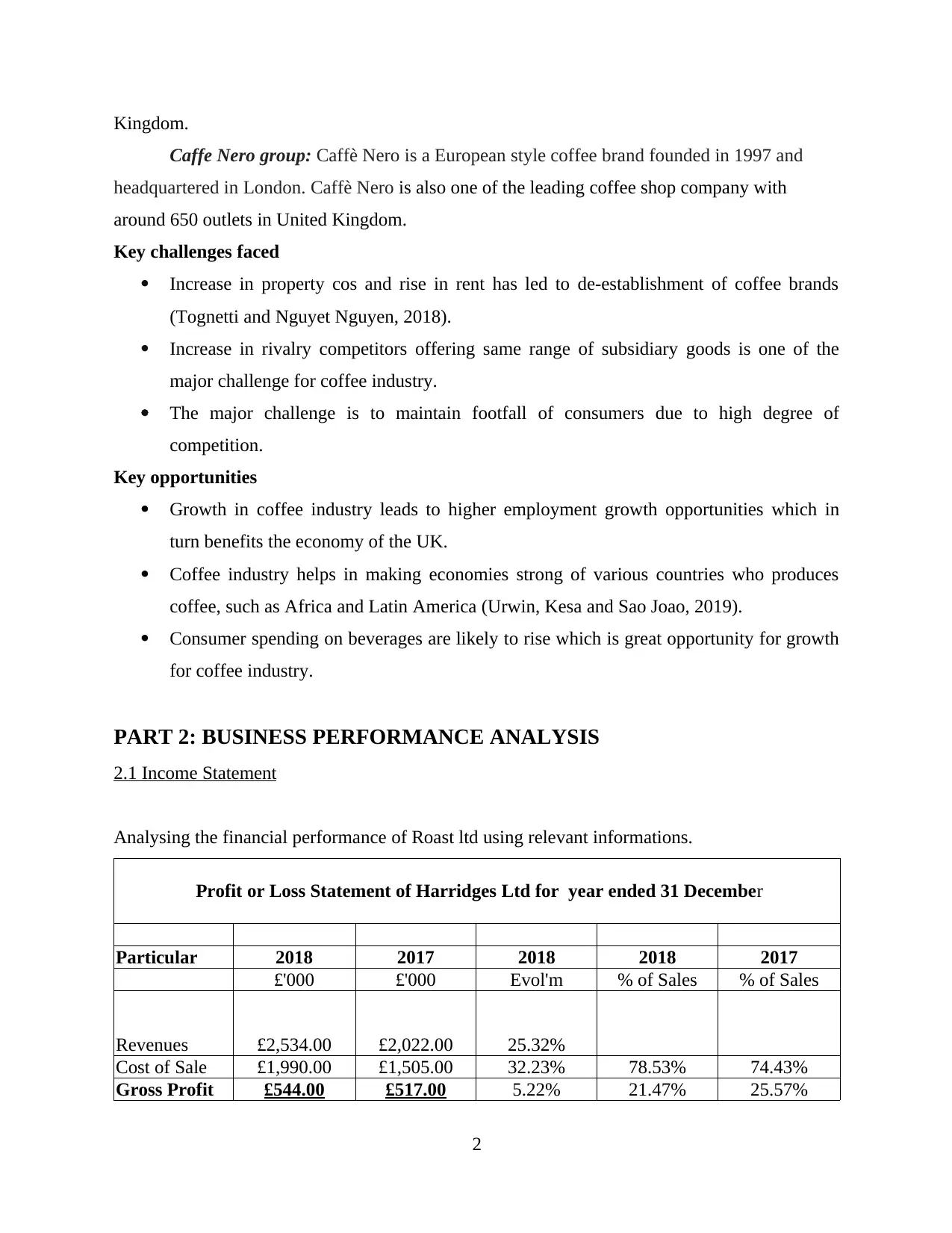
Kingdom.
Caffe Nero group: Caffè Nero is a European style coffee brand founded in 1997 and
headquartered in London. Caffè Nero is also one of the leading coffee shop company with
around 650 outlets in United Kingdom.
Key challenges faced
Increase in property cos and rise in rent has led to de-establishment of coffee brands
(Tognetti and Nguyet Nguyen, 2018).
Increase in rivalry competitors offering same range of subsidiary goods is one of the
major challenge for coffee industry.
The major challenge is to maintain footfall of consumers due to high degree of
competition.
Key opportunities
Growth in coffee industry leads to higher employment growth opportunities which in
turn benefits the economy of the UK.
Coffee industry helps in making economies strong of various countries who produces
coffee, such as Africa and Latin America (Urwin, Kesa and Sao Joao, 2019).
Consumer spending on beverages are likely to rise which is great opportunity for growth
for coffee industry.
PART 2: BUSINESS PERFORMANCE ANALYSIS
2.1 Income Statement
Analysing the financial performance of Roast ltd using relevant informations.
Profit or Loss Statement of Harridges Ltd for year ended 31 December
Particular 2018 2017 2018 2018 2017
£'000 £'000 Evol'm % of Sales % of Sales
Revenues £2,534.00 £2,022.00 25.32%
Cost of Sale £1,990.00 £1,505.00 32.23% 78.53% 74.43%
Gross Profit £544.00 £517.00 5.22% 21.47% 25.57%
2
Caffe Nero group: Caffè Nero is a European style coffee brand founded in 1997 and
headquartered in London. Caffè Nero is also one of the leading coffee shop company with
around 650 outlets in United Kingdom.
Key challenges faced
Increase in property cos and rise in rent has led to de-establishment of coffee brands
(Tognetti and Nguyet Nguyen, 2018).
Increase in rivalry competitors offering same range of subsidiary goods is one of the
major challenge for coffee industry.
The major challenge is to maintain footfall of consumers due to high degree of
competition.
Key opportunities
Growth in coffee industry leads to higher employment growth opportunities which in
turn benefits the economy of the UK.
Coffee industry helps in making economies strong of various countries who produces
coffee, such as Africa and Latin America (Urwin, Kesa and Sao Joao, 2019).
Consumer spending on beverages are likely to rise which is great opportunity for growth
for coffee industry.
PART 2: BUSINESS PERFORMANCE ANALYSIS
2.1 Income Statement
Analysing the financial performance of Roast ltd using relevant informations.
Profit or Loss Statement of Harridges Ltd for year ended 31 December
Particular 2018 2017 2018 2018 2017
£'000 £'000 Evol'm % of Sales % of Sales
Revenues £2,534.00 £2,022.00 25.32%
Cost of Sale £1,990.00 £1,505.00 32.23% 78.53% 74.43%
Gross Profit £544.00 £517.00 5.22% 21.47% 25.57%
2
Paraphrase This Document
Need a fresh take? Get an instant paraphrase of this document with our AI Paraphraser
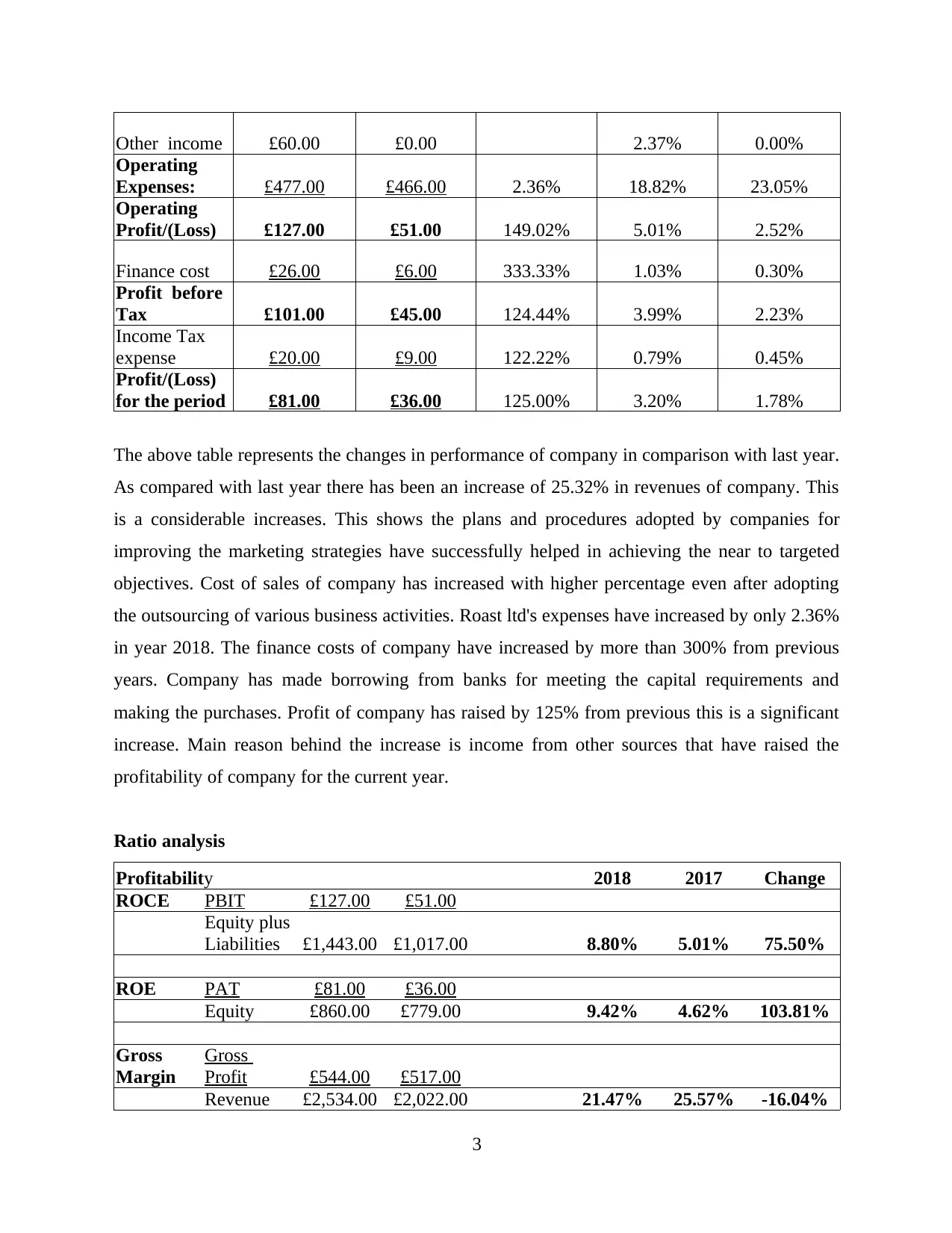
Other income £60.00 £0.00 2.37% 0.00%
Operating
Expenses: £477.00 £466.00 2.36% 18.82% 23.05%
Operating
Profit/(Loss) £127.00 £51.00 149.02% 5.01% 2.52%
Finance cost £26.00 £6.00 333.33% 1.03% 0.30%
Profit before
Tax £101.00 £45.00 124.44% 3.99% 2.23%
Income Tax
expense £20.00 £9.00 122.22% 0.79% 0.45%
Profit/(Loss)
for the period £81.00 £36.00 125.00% 3.20% 1.78%
The above table represents the changes in performance of company in comparison with last year.
As compared with last year there has been an increase of 25.32% in revenues of company. This
is a considerable increases. This shows the plans and procedures adopted by companies for
improving the marketing strategies have successfully helped in achieving the near to targeted
objectives. Cost of sales of company has increased with higher percentage even after adopting
the outsourcing of various business activities. Roast ltd's expenses have increased by only 2.36%
in year 2018. The finance costs of company have increased by more than 300% from previous
years. Company has made borrowing from banks for meeting the capital requirements and
making the purchases. Profit of company has raised by 125% from previous this is a significant
increase. Main reason behind the increase is income from other sources that have raised the
profitability of company for the current year.
Ratio analysis
Profitability 2018 2017 Change
ROCE PBIT £127.00 £51.00
Equity plus
Liabilities £1,443.00 £1,017.00 8.80% 5.01% 75.50%
ROE PAT £81.00 £36.00
Equity £860.00 £779.00 9.42% 4.62% 103.81%
Gross
Margin
Gross
Profit £544.00 £517.00
Revenue £2,534.00 £2,022.00 21.47% 25.57% -16.04%
3
Operating
Expenses: £477.00 £466.00 2.36% 18.82% 23.05%
Operating
Profit/(Loss) £127.00 £51.00 149.02% 5.01% 2.52%
Finance cost £26.00 £6.00 333.33% 1.03% 0.30%
Profit before
Tax £101.00 £45.00 124.44% 3.99% 2.23%
Income Tax
expense £20.00 £9.00 122.22% 0.79% 0.45%
Profit/(Loss)
for the period £81.00 £36.00 125.00% 3.20% 1.78%
The above table represents the changes in performance of company in comparison with last year.
As compared with last year there has been an increase of 25.32% in revenues of company. This
is a considerable increases. This shows the plans and procedures adopted by companies for
improving the marketing strategies have successfully helped in achieving the near to targeted
objectives. Cost of sales of company has increased with higher percentage even after adopting
the outsourcing of various business activities. Roast ltd's expenses have increased by only 2.36%
in year 2018. The finance costs of company have increased by more than 300% from previous
years. Company has made borrowing from banks for meeting the capital requirements and
making the purchases. Profit of company has raised by 125% from previous this is a significant
increase. Main reason behind the increase is income from other sources that have raised the
profitability of company for the current year.
Ratio analysis
Profitability 2018 2017 Change
ROCE PBIT £127.00 £51.00
Equity plus
Liabilities £1,443.00 £1,017.00 8.80% 5.01% 75.50%
ROE PAT £81.00 £36.00
Equity £860.00 £779.00 9.42% 4.62% 103.81%
Gross
Margin
Gross
Profit £544.00 £517.00
Revenue £2,534.00 £2,022.00 21.47% 25.57% -16.04%
3

Net
Margin PBIT £127.00 £51.00
Revenue £2,534.00 £2,022.00 5.01% 2.52% 98.70%
The ROCE of company for current year is 8.80%. ROCE of company has increased from
previous year. Company must have adequate return over the capital employed by owners. If
company is unable to earn reasonable rate of return than its shows the company is not utilising
the available resources adequately to earn revenues. Further return over capital employed can be
enhanced by removing the unproductive assets from company.
Return over equity represents return earned over the investments. Return over equity is
against the profits earned by company (Robinson, 2020). Profits of company have to be
increased by taking appropriate steps. ROE of company is 9.42% and increase is more than
100%. It is essential to identify the reasons behind the significant increase in return. There are
possibilities that the profits are misrepresented therefore it is identify the factors responsible for
increase.
Gross profit margin represents amount left with company after carrying out all the production
costs. Gross margin is 21.47% that is decline from previous year. The reason behind decline is
the increased production costs. Costs of imports have raised the prices of raw materials
purchased from abroad.
Net profit margin of company is 5.01% that has doubled from previous year. The reason
behind rise in net profits is the extra income earned by company. This is temporary income
earned by company that might not be earned every year (Altman and et.al., 2017). Therefore the
increase could not be taken as due to increase in revenues or enhancement of the operational
processes.
2.2 Statement of Balance Sheet
Balance sheet statement is prepared for presenting the financial health of company. It includes
all the assets and liabilities of company. Every item presented in the balance sheet is of
importance and is to be analysed appropriately by the users of financial statements.
Ratio Analysis
Liquidity
4
Margin PBIT £127.00 £51.00
Revenue £2,534.00 £2,022.00 5.01% 2.52% 98.70%
The ROCE of company for current year is 8.80%. ROCE of company has increased from
previous year. Company must have adequate return over the capital employed by owners. If
company is unable to earn reasonable rate of return than its shows the company is not utilising
the available resources adequately to earn revenues. Further return over capital employed can be
enhanced by removing the unproductive assets from company.
Return over equity represents return earned over the investments. Return over equity is
against the profits earned by company (Robinson, 2020). Profits of company have to be
increased by taking appropriate steps. ROE of company is 9.42% and increase is more than
100%. It is essential to identify the reasons behind the significant increase in return. There are
possibilities that the profits are misrepresented therefore it is identify the factors responsible for
increase.
Gross profit margin represents amount left with company after carrying out all the production
costs. Gross margin is 21.47% that is decline from previous year. The reason behind decline is
the increased production costs. Costs of imports have raised the prices of raw materials
purchased from abroad.
Net profit margin of company is 5.01% that has doubled from previous year. The reason
behind rise in net profits is the extra income earned by company. This is temporary income
earned by company that might not be earned every year (Altman and et.al., 2017). Therefore the
increase could not be taken as due to increase in revenues or enhancement of the operational
processes.
2.2 Statement of Balance Sheet
Balance sheet statement is prepared for presenting the financial health of company. It includes
all the assets and liabilities of company. Every item presented in the balance sheet is of
importance and is to be analysed appropriately by the users of financial statements.
Ratio Analysis
Liquidity
4
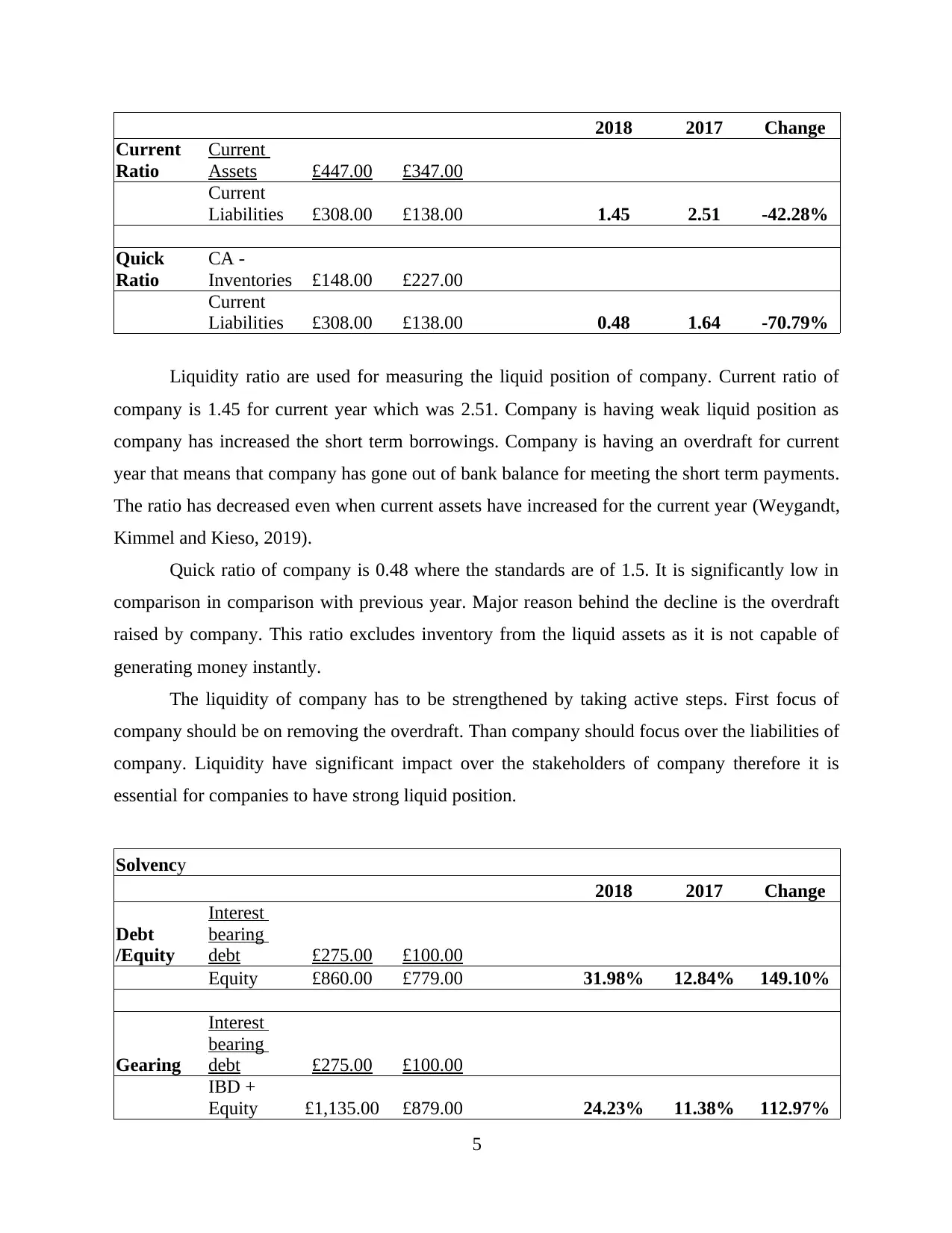
2018 2017 Change
Current
Ratio
Current
Assets £447.00 £347.00
Current
Liabilities £308.00 £138.00 1.45 2.51 -42.28%
Quick
Ratio
CA -
Inventories £148.00 £227.00
Current
Liabilities £308.00 £138.00 0.48 1.64 -70.79%
Liquidity ratio are used for measuring the liquid position of company. Current ratio of
company is 1.45 for current year which was 2.51. Company is having weak liquid position as
company has increased the short term borrowings. Company is having an overdraft for current
year that means that company has gone out of bank balance for meeting the short term payments.
The ratio has decreased even when current assets have increased for the current year (Weygandt,
Kimmel and Kieso, 2019).
Quick ratio of company is 0.48 where the standards are of 1.5. It is significantly low in
comparison in comparison with previous year. Major reason behind the decline is the overdraft
raised by company. This ratio excludes inventory from the liquid assets as it is not capable of
generating money instantly.
The liquidity of company has to be strengthened by taking active steps. First focus of
company should be on removing the overdraft. Than company should focus over the liabilities of
company. Liquidity have significant impact over the stakeholders of company therefore it is
essential for companies to have strong liquid position.
Solvency
2018 2017 Change
Debt
/Equity
Interest
bearing
debt £275.00 £100.00
Equity £860.00 £779.00 31.98% 12.84% 149.10%
Gearing
Interest
bearing
debt £275.00 £100.00
IBD +
Equity £1,135.00 £879.00 24.23% 11.38% 112.97%
5
Current
Ratio
Current
Assets £447.00 £347.00
Current
Liabilities £308.00 £138.00 1.45 2.51 -42.28%
Quick
Ratio
CA -
Inventories £148.00 £227.00
Current
Liabilities £308.00 £138.00 0.48 1.64 -70.79%
Liquidity ratio are used for measuring the liquid position of company. Current ratio of
company is 1.45 for current year which was 2.51. Company is having weak liquid position as
company has increased the short term borrowings. Company is having an overdraft for current
year that means that company has gone out of bank balance for meeting the short term payments.
The ratio has decreased even when current assets have increased for the current year (Weygandt,
Kimmel and Kieso, 2019).
Quick ratio of company is 0.48 where the standards are of 1.5. It is significantly low in
comparison in comparison with previous year. Major reason behind the decline is the overdraft
raised by company. This ratio excludes inventory from the liquid assets as it is not capable of
generating money instantly.
The liquidity of company has to be strengthened by taking active steps. First focus of
company should be on removing the overdraft. Than company should focus over the liabilities of
company. Liquidity have significant impact over the stakeholders of company therefore it is
essential for companies to have strong liquid position.
Solvency
2018 2017 Change
Debt
/Equity
Interest
bearing
debt £275.00 £100.00
Equity £860.00 £779.00 31.98% 12.84% 149.10%
Gearing
Interest
bearing
debt £275.00 £100.00
IBD +
Equity £1,135.00 £879.00 24.23% 11.38% 112.97%
5
Secure Best Marks with AI Grader
Need help grading? Try our AI Grader for instant feedback on your assignments.
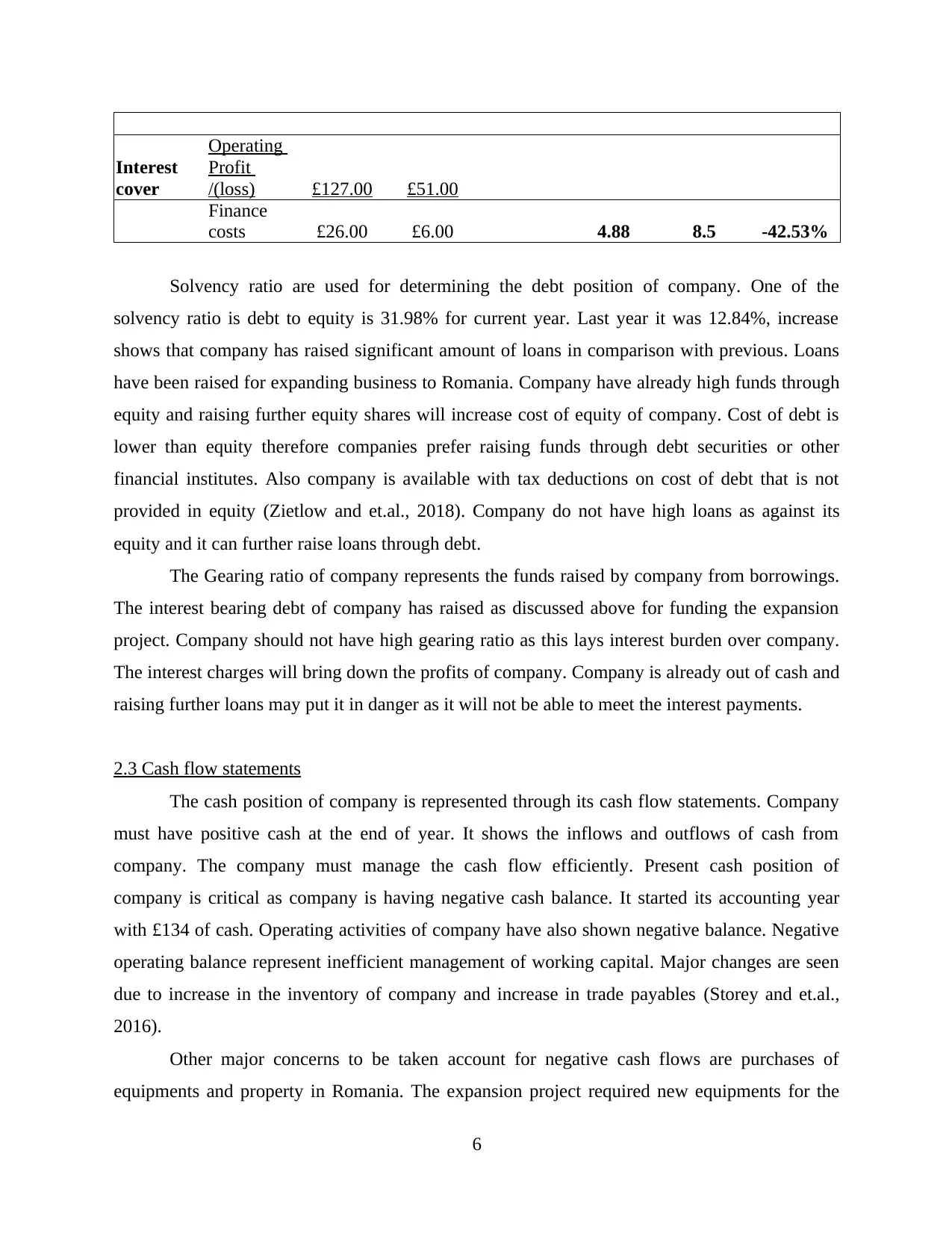
Interest
cover
Operating
Profit
/(loss) £127.00 £51.00
Finance
costs £26.00 £6.00 4.88 8.5 -42.53%
Solvency ratio are used for determining the debt position of company. One of the
solvency ratio is debt to equity is 31.98% for current year. Last year it was 12.84%, increase
shows that company has raised significant amount of loans in comparison with previous. Loans
have been raised for expanding business to Romania. Company have already high funds through
equity and raising further equity shares will increase cost of equity of company. Cost of debt is
lower than equity therefore companies prefer raising funds through debt securities or other
financial institutes. Also company is available with tax deductions on cost of debt that is not
provided in equity (Zietlow and et.al., 2018). Company do not have high loans as against its
equity and it can further raise loans through debt.
The Gearing ratio of company represents the funds raised by company from borrowings.
The interest bearing debt of company has raised as discussed above for funding the expansion
project. Company should not have high gearing ratio as this lays interest burden over company.
The interest charges will bring down the profits of company. Company is already out of cash and
raising further loans may put it in danger as it will not be able to meet the interest payments.
2.3 Cash flow statements
The cash position of company is represented through its cash flow statements. Company
must have positive cash at the end of year. It shows the inflows and outflows of cash from
company. The company must manage the cash flow efficiently. Present cash position of
company is critical as company is having negative cash balance. It started its accounting year
with £134 of cash. Operating activities of company have also shown negative balance. Negative
operating balance represent inefficient management of working capital. Major changes are seen
due to increase in the inventory of company and increase in trade payables (Storey and et.al.,
2016).
Other major concerns to be taken account for negative cash flows are purchases of
equipments and property in Romania. The expansion project required new equipments for the
6
cover
Operating
Profit
/(loss) £127.00 £51.00
Finance
costs £26.00 £6.00 4.88 8.5 -42.53%
Solvency ratio are used for determining the debt position of company. One of the
solvency ratio is debt to equity is 31.98% for current year. Last year it was 12.84%, increase
shows that company has raised significant amount of loans in comparison with previous. Loans
have been raised for expanding business to Romania. Company have already high funds through
equity and raising further equity shares will increase cost of equity of company. Cost of debt is
lower than equity therefore companies prefer raising funds through debt securities or other
financial institutes. Also company is available with tax deductions on cost of debt that is not
provided in equity (Zietlow and et.al., 2018). Company do not have high loans as against its
equity and it can further raise loans through debt.
The Gearing ratio of company represents the funds raised by company from borrowings.
The interest bearing debt of company has raised as discussed above for funding the expansion
project. Company should not have high gearing ratio as this lays interest burden over company.
The interest charges will bring down the profits of company. Company is already out of cash and
raising further loans may put it in danger as it will not be able to meet the interest payments.
2.3 Cash flow statements
The cash position of company is represented through its cash flow statements. Company
must have positive cash at the end of year. It shows the inflows and outflows of cash from
company. The company must manage the cash flow efficiently. Present cash position of
company is critical as company is having negative cash balance. It started its accounting year
with £134 of cash. Operating activities of company have also shown negative balance. Negative
operating balance represent inefficient management of working capital. Major changes are seen
due to increase in the inventory of company and increase in trade payables (Storey and et.al.,
2016).
Other major concerns to be taken account for negative cash flows are purchases of
equipments and property in Romania. The expansion project required new equipments for the
6
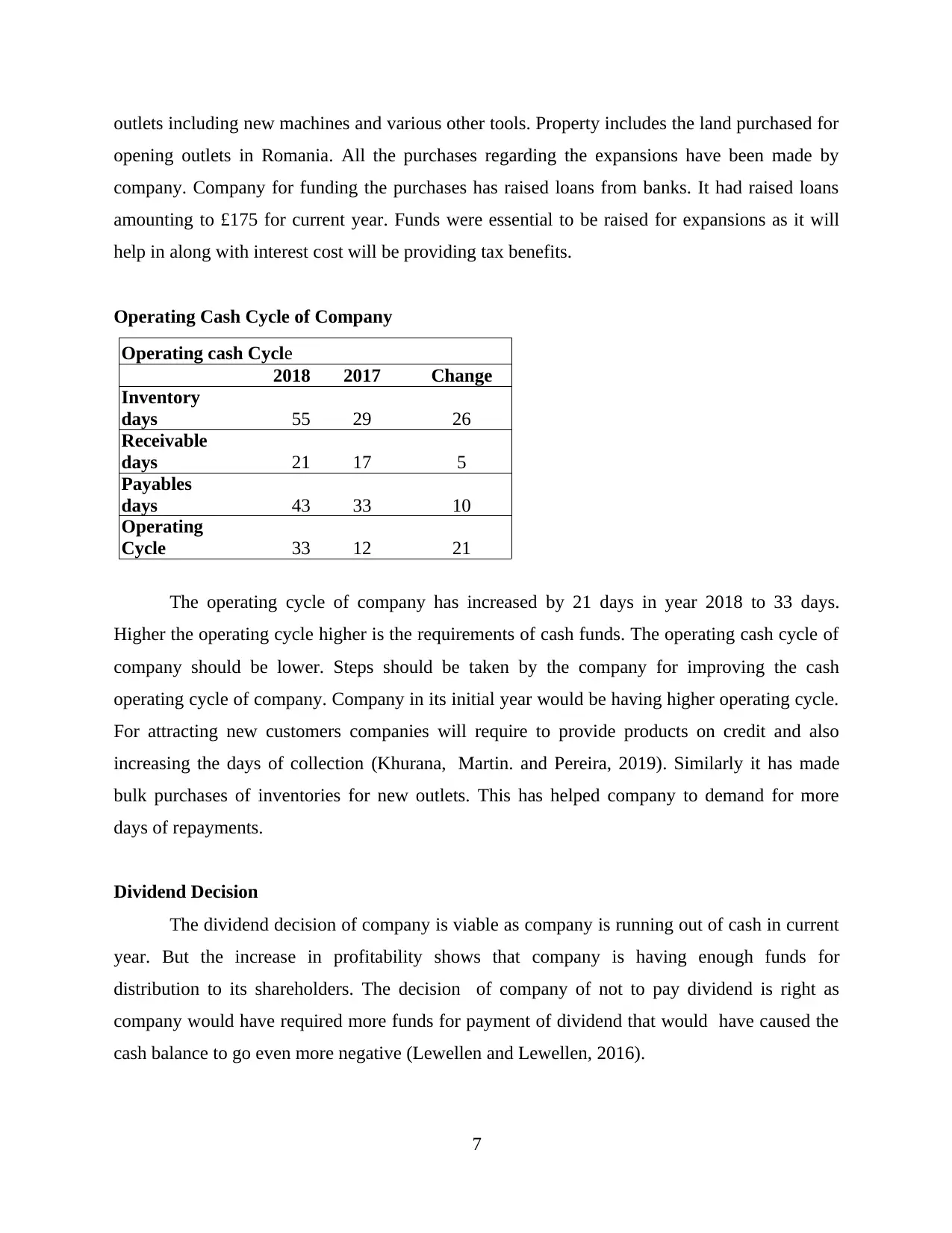
outlets including new machines and various other tools. Property includes the land purchased for
opening outlets in Romania. All the purchases regarding the expansions have been made by
company. Company for funding the purchases has raised loans from banks. It had raised loans
amounting to £175 for current year. Funds were essential to be raised for expansions as it will
help in along with interest cost will be providing tax benefits.
Operating Cash Cycle of Company
Operating cash Cycle
2018 2017 Change
Inventory
days 55 29 26
Receivable
days 21 17 5
Payables
days 43 33 10
Operating
Cycle 33 12 21
The operating cycle of company has increased by 21 days in year 2018 to 33 days.
Higher the operating cycle higher is the requirements of cash funds. The operating cash cycle of
company should be lower. Steps should be taken by the company for improving the cash
operating cycle of company. Company in its initial year would be having higher operating cycle.
For attracting new customers companies will require to provide products on credit and also
increasing the days of collection (Khurana, Martin. and Pereira, 2019). Similarly it has made
bulk purchases of inventories for new outlets. This has helped company to demand for more
days of repayments.
Dividend Decision
The dividend decision of company is viable as company is running out of cash in current
year. But the increase in profitability shows that company is having enough funds for
distribution to its shareholders. The decision of company of not to pay dividend is right as
company would have required more funds for payment of dividend that would have caused the
cash balance to go even more negative (Lewellen and Lewellen, 2016).
7
opening outlets in Romania. All the purchases regarding the expansions have been made by
company. Company for funding the purchases has raised loans from banks. It had raised loans
amounting to £175 for current year. Funds were essential to be raised for expansions as it will
help in along with interest cost will be providing tax benefits.
Operating Cash Cycle of Company
Operating cash Cycle
2018 2017 Change
Inventory
days 55 29 26
Receivable
days 21 17 5
Payables
days 43 33 10
Operating
Cycle 33 12 21
The operating cycle of company has increased by 21 days in year 2018 to 33 days.
Higher the operating cycle higher is the requirements of cash funds. The operating cash cycle of
company should be lower. Steps should be taken by the company for improving the cash
operating cycle of company. Company in its initial year would be having higher operating cycle.
For attracting new customers companies will require to provide products on credit and also
increasing the days of collection (Khurana, Martin. and Pereira, 2019). Similarly it has made
bulk purchases of inventories for new outlets. This has helped company to demand for more
days of repayments.
Dividend Decision
The dividend decision of company is viable as company is running out of cash in current
year. But the increase in profitability shows that company is having enough funds for
distribution to its shareholders. The decision of company of not to pay dividend is right as
company would have required more funds for payment of dividend that would have caused the
cash balance to go even more negative (Lewellen and Lewellen, 2016).
7
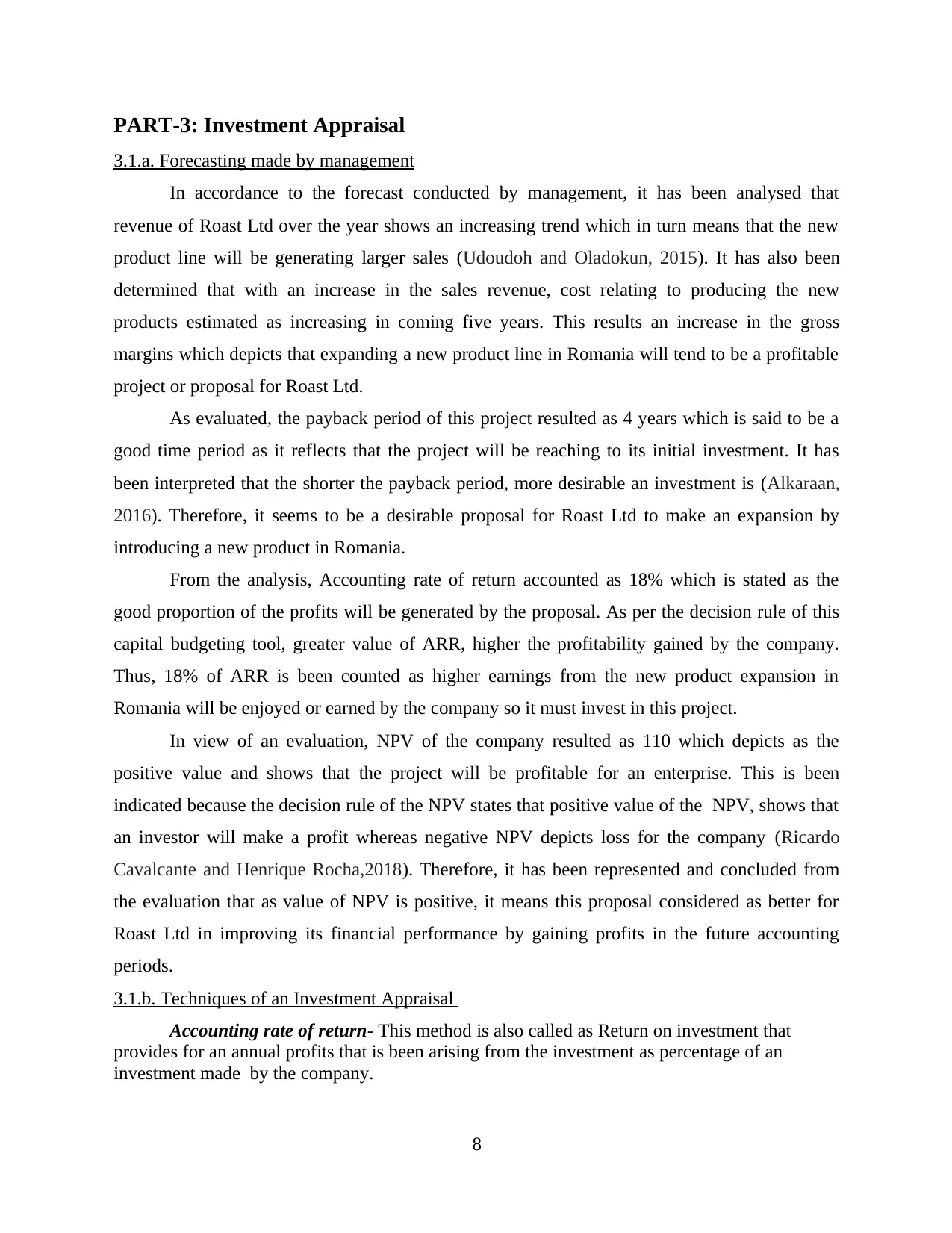
PART-3: Investment Appraisal
3.1.a. Forecasting made by management
In accordance to the forecast conducted by management, it has been analysed that
revenue of Roast Ltd over the year shows an increasing trend which in turn means that the new
product line will be generating larger sales (Udoudoh and Oladokun, 2015). It has also been
determined that with an increase in the sales revenue, cost relating to producing the new
products estimated as increasing in coming five years. This results an increase in the gross
margins which depicts that expanding a new product line in Romania will tend to be a profitable
project or proposal for Roast Ltd.
As evaluated, the payback period of this project resulted as 4 years which is said to be a
good time period as it reflects that the project will be reaching to its initial investment. It has
been interpreted that the shorter the payback period, more desirable an investment is (Alkaraan,
2016). Therefore, it seems to be a desirable proposal for Roast Ltd to make an expansion by
introducing a new product in Romania.
From the analysis, Accounting rate of return accounted as 18% which is stated as the
good proportion of the profits will be generated by the proposal. As per the decision rule of this
capital budgeting tool, greater value of ARR, higher the profitability gained by the company.
Thus, 18% of ARR is been counted as higher earnings from the new product expansion in
Romania will be enjoyed or earned by the company so it must invest in this project.
In view of an evaluation, NPV of the company resulted as 110 which depicts as the
positive value and shows that the project will be profitable for an enterprise. This is been
indicated because the decision rule of the NPV states that positive value of the NPV, shows that
an investor will make a profit whereas negative NPV depicts loss for the company (Ricardo
Cavalcante and Henrique Rocha,2018). Therefore, it has been represented and concluded from
the evaluation that as value of NPV is positive, it means this proposal considered as better for
Roast Ltd in improving its financial performance by gaining profits in the future accounting
periods.
3.1.b. Techniques of an Investment Appraisal
Accounting rate of return- This method is also called as Return on investment that
provides for an annual profits that is been arising from the investment as percentage of an
investment made by the company.
8
3.1.a. Forecasting made by management
In accordance to the forecast conducted by management, it has been analysed that
revenue of Roast Ltd over the year shows an increasing trend which in turn means that the new
product line will be generating larger sales (Udoudoh and Oladokun, 2015). It has also been
determined that with an increase in the sales revenue, cost relating to producing the new
products estimated as increasing in coming five years. This results an increase in the gross
margins which depicts that expanding a new product line in Romania will tend to be a profitable
project or proposal for Roast Ltd.
As evaluated, the payback period of this project resulted as 4 years which is said to be a
good time period as it reflects that the project will be reaching to its initial investment. It has
been interpreted that the shorter the payback period, more desirable an investment is (Alkaraan,
2016). Therefore, it seems to be a desirable proposal for Roast Ltd to make an expansion by
introducing a new product in Romania.
From the analysis, Accounting rate of return accounted as 18% which is stated as the
good proportion of the profits will be generated by the proposal. As per the decision rule of this
capital budgeting tool, greater value of ARR, higher the profitability gained by the company.
Thus, 18% of ARR is been counted as higher earnings from the new product expansion in
Romania will be enjoyed or earned by the company so it must invest in this project.
In view of an evaluation, NPV of the company resulted as 110 which depicts as the
positive value and shows that the project will be profitable for an enterprise. This is been
indicated because the decision rule of the NPV states that positive value of the NPV, shows that
an investor will make a profit whereas negative NPV depicts loss for the company (Ricardo
Cavalcante and Henrique Rocha,2018). Therefore, it has been represented and concluded from
the evaluation that as value of NPV is positive, it means this proposal considered as better for
Roast Ltd in improving its financial performance by gaining profits in the future accounting
periods.
3.1.b. Techniques of an Investment Appraisal
Accounting rate of return- This method is also called as Return on investment that
provides for an annual profits that is been arising from the investment as percentage of an
investment made by the company.
8
Paraphrase This Document
Need a fresh take? Get an instant paraphrase of this document with our AI Paraphraser
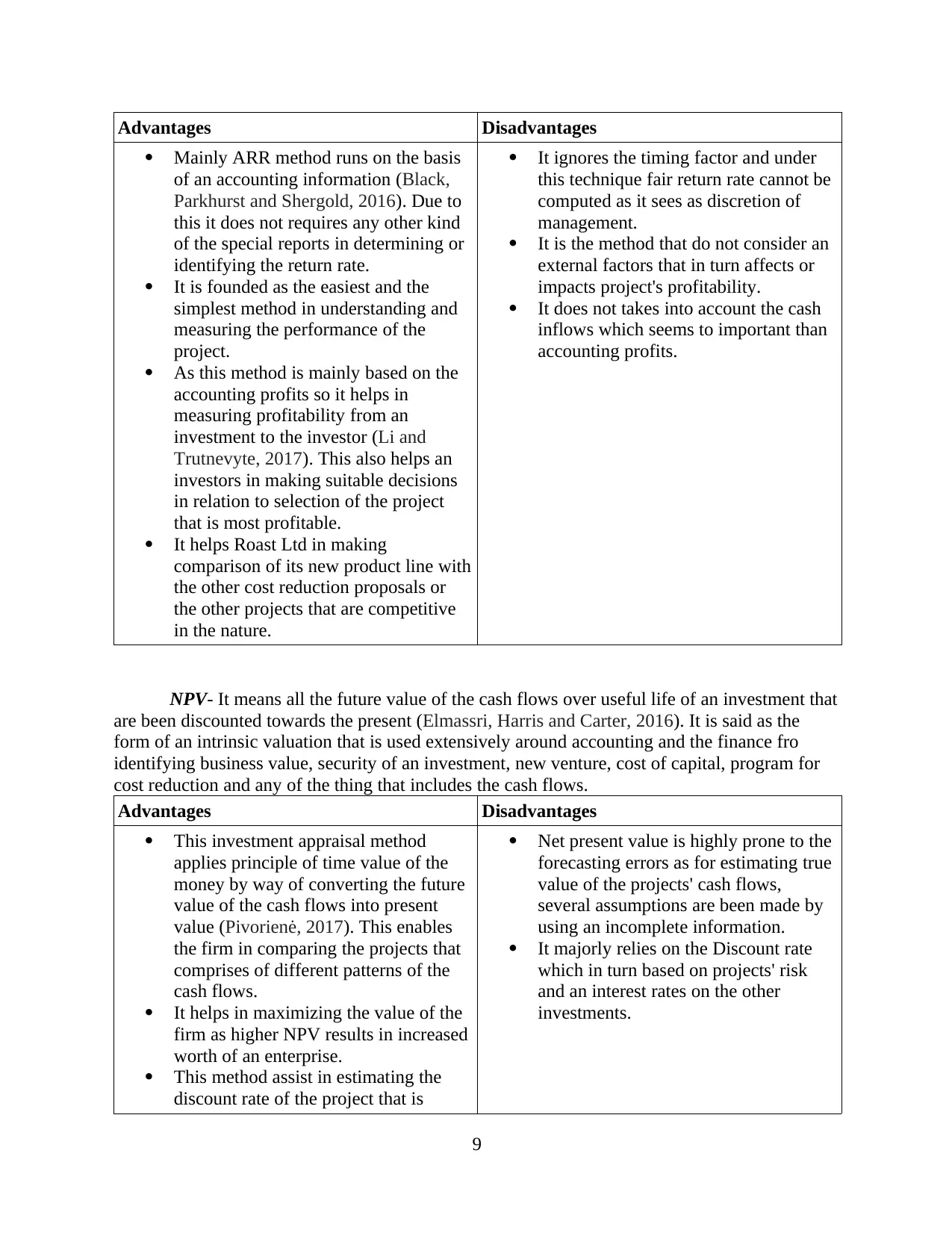
Advantages Disadvantages
Mainly ARR method runs on the basis
of an accounting information (Black,
Parkhurst and Shergold, 2016). Due to
this it does not requires any other kind
of the special reports in determining or
identifying the return rate.
It is founded as the easiest and the
simplest method in understanding and
measuring the performance of the
project.
As this method is mainly based on the
accounting profits so it helps in
measuring profitability from an
investment to the investor (Li and
Trutnevyte, 2017). This also helps an
investors in making suitable decisions
in relation to selection of the project
that is most profitable.
It helps Roast Ltd in making
comparison of its new product line with
the other cost reduction proposals or
the other projects that are competitive
in the nature.
It ignores the timing factor and under
this technique fair return rate cannot be
computed as it sees as discretion of
management.
It is the method that do not consider an
external factors that in turn affects or
impacts project's profitability.
It does not takes into account the cash
inflows which seems to important than
accounting profits.
NPV- It means all the future value of the cash flows over useful life of an investment that
are been discounted towards the present (Elmassri, Harris and Carter, 2016). It is said as the
form of an intrinsic valuation that is used extensively around accounting and the finance fro
identifying business value, security of an investment, new venture, cost of capital, program for
cost reduction and any of the thing that includes the cash flows.
Advantages Disadvantages
This investment appraisal method
applies principle of time value of the
money by way of converting the future
value of the cash flows into present
value (Pivorienė, 2017). This enables
the firm in comparing the projects that
comprises of different patterns of the
cash flows.
It helps in maximizing the value of the
firm as higher NPV results in increased
worth of an enterprise.
This method assist in estimating the
discount rate of the project that is
Net present value is highly prone to the
forecasting errors as for estimating true
value of the projects' cash flows,
several assumptions are been made by
using an incomplete information.
It majorly relies on the Discount rate
which in turn based on projects' risk
and an interest rates on the other
investments.
9
Mainly ARR method runs on the basis
of an accounting information (Black,
Parkhurst and Shergold, 2016). Due to
this it does not requires any other kind
of the special reports in determining or
identifying the return rate.
It is founded as the easiest and the
simplest method in understanding and
measuring the performance of the
project.
As this method is mainly based on the
accounting profits so it helps in
measuring profitability from an
investment to the investor (Li and
Trutnevyte, 2017). This also helps an
investors in making suitable decisions
in relation to selection of the project
that is most profitable.
It helps Roast Ltd in making
comparison of its new product line with
the other cost reduction proposals or
the other projects that are competitive
in the nature.
It ignores the timing factor and under
this technique fair return rate cannot be
computed as it sees as discretion of
management.
It is the method that do not consider an
external factors that in turn affects or
impacts project's profitability.
It does not takes into account the cash
inflows which seems to important than
accounting profits.
NPV- It means all the future value of the cash flows over useful life of an investment that
are been discounted towards the present (Elmassri, Harris and Carter, 2016). It is said as the
form of an intrinsic valuation that is used extensively around accounting and the finance fro
identifying business value, security of an investment, new venture, cost of capital, program for
cost reduction and any of the thing that includes the cash flows.
Advantages Disadvantages
This investment appraisal method
applies principle of time value of the
money by way of converting the future
value of the cash flows into present
value (Pivorienė, 2017). This enables
the firm in comparing the projects that
comprises of different patterns of the
cash flows.
It helps in maximizing the value of the
firm as higher NPV results in increased
worth of an enterprise.
This method assist in estimating the
discount rate of the project that is
Net present value is highly prone to the
forecasting errors as for estimating true
value of the projects' cash flows,
several assumptions are been made by
using an incomplete information.
It majorly relies on the Discount rate
which in turn based on projects' risk
and an interest rates on the other
investments.
9
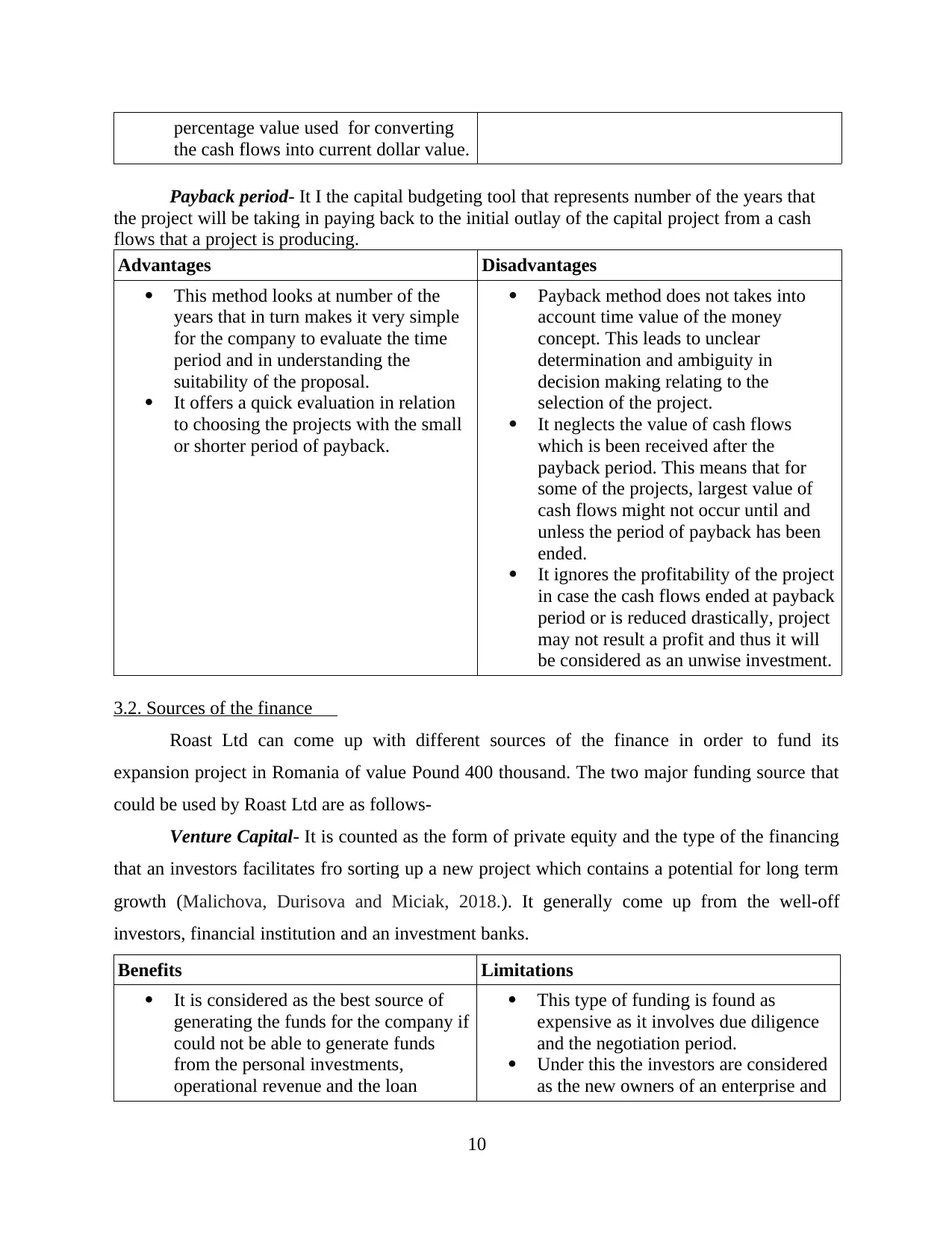
percentage value used for converting
the cash flows into current dollar value.
Payback period- It I the capital budgeting tool that represents number of the years that
the project will be taking in paying back to the initial outlay of the capital project from a cash
flows that a project is producing.
Advantages Disadvantages
This method looks at number of the
years that in turn makes it very simple
for the company to evaluate the time
period and in understanding the
suitability of the proposal.
It offers a quick evaluation in relation
to choosing the projects with the small
or shorter period of payback.
Payback method does not takes into
account time value of the money
concept. This leads to unclear
determination and ambiguity in
decision making relating to the
selection of the project.
It neglects the value of cash flows
which is been received after the
payback period. This means that for
some of the projects, largest value of
cash flows might not occur until and
unless the period of payback has been
ended.
It ignores the profitability of the project
in case the cash flows ended at payback
period or is reduced drastically, project
may not result a profit and thus it will
be considered as an unwise investment.
3.2. Sources of the finance
Roast Ltd can come up with different sources of the finance in order to fund its
expansion project in Romania of value Pound 400 thousand. The two major funding source that
could be used by Roast Ltd are as follows-
Venture Capital- It is counted as the form of private equity and the type of the financing
that an investors facilitates fro sorting up a new project which contains a potential for long term
growth (Malichova, Durisova and Miciak, 2018.). It generally come up from the well-off
investors, financial institution and an investment banks.
Benefits Limitations
It is considered as the best source of
generating the funds for the company if
could not be able to generate funds
from the personal investments,
operational revenue and the loan
This type of funding is found as
expensive as it involves due diligence
and the negotiation period.
Under this the investors are considered
as the new owners of an enterprise and
10
the cash flows into current dollar value.
Payback period- It I the capital budgeting tool that represents number of the years that
the project will be taking in paying back to the initial outlay of the capital project from a cash
flows that a project is producing.
Advantages Disadvantages
This method looks at number of the
years that in turn makes it very simple
for the company to evaluate the time
period and in understanding the
suitability of the proposal.
It offers a quick evaluation in relation
to choosing the projects with the small
or shorter period of payback.
Payback method does not takes into
account time value of the money
concept. This leads to unclear
determination and ambiguity in
decision making relating to the
selection of the project.
It neglects the value of cash flows
which is been received after the
payback period. This means that for
some of the projects, largest value of
cash flows might not occur until and
unless the period of payback has been
ended.
It ignores the profitability of the project
in case the cash flows ended at payback
period or is reduced drastically, project
may not result a profit and thus it will
be considered as an unwise investment.
3.2. Sources of the finance
Roast Ltd can come up with different sources of the finance in order to fund its
expansion project in Romania of value Pound 400 thousand. The two major funding source that
could be used by Roast Ltd are as follows-
Venture Capital- It is counted as the form of private equity and the type of the financing
that an investors facilitates fro sorting up a new project which contains a potential for long term
growth (Malichova, Durisova and Miciak, 2018.). It generally come up from the well-off
investors, financial institution and an investment banks.
Benefits Limitations
It is considered as the best source of
generating the funds for the company if
could not be able to generate funds
from the personal investments,
operational revenue and the loan
This type of funding is found as
expensive as it involves due diligence
and the negotiation period.
Under this the investors are considered
as the new owners of an enterprise and
10
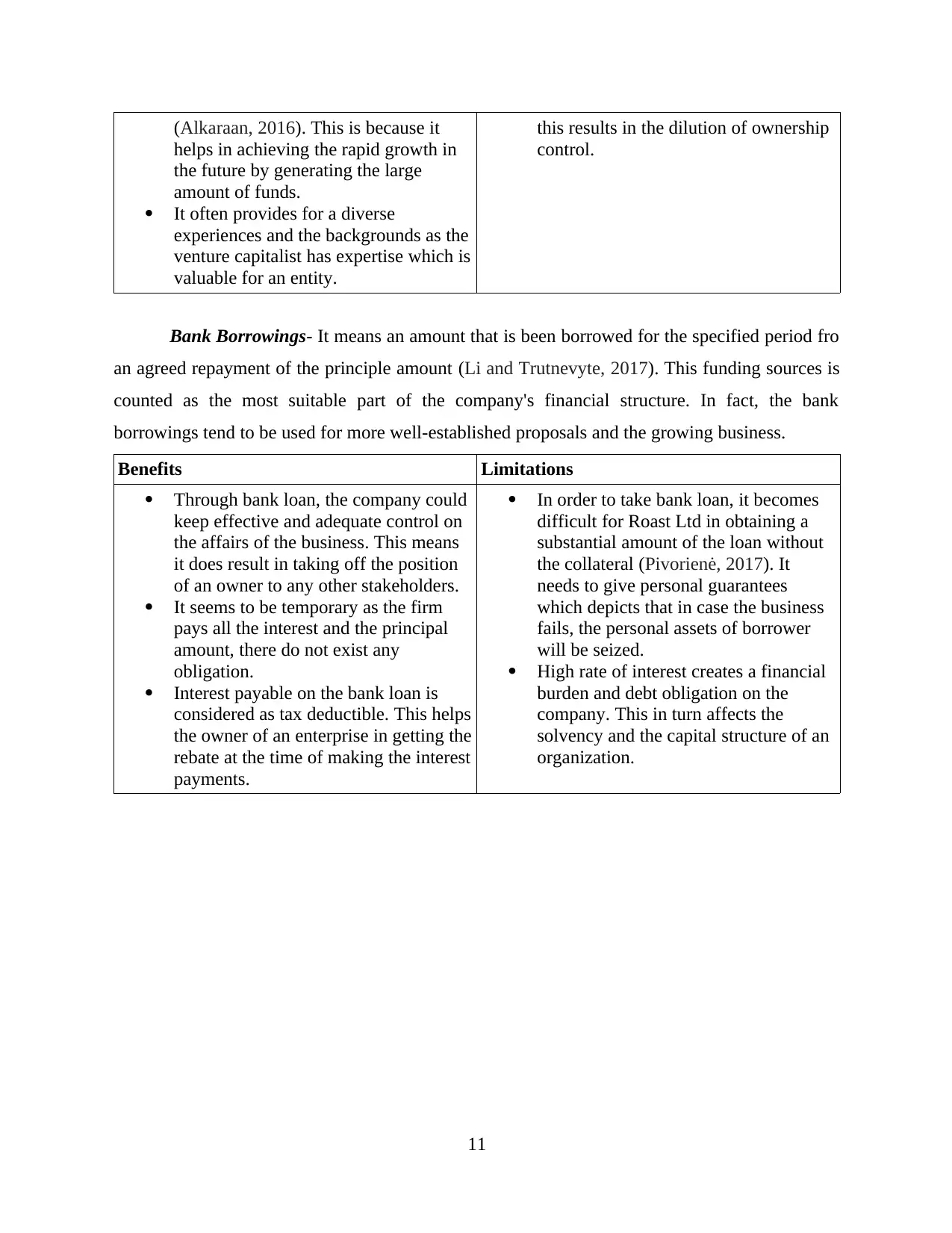
(Alkaraan, 2016). This is because it
helps in achieving the rapid growth in
the future by generating the large
amount of funds.
It often provides for a diverse
experiences and the backgrounds as the
venture capitalist has expertise which is
valuable for an entity.
this results in the dilution of ownership
control.
Bank Borrowings- It means an amount that is been borrowed for the specified period fro
an agreed repayment of the principle amount (Li and Trutnevyte, 2017). This funding sources is
counted as the most suitable part of the company's financial structure. In fact, the bank
borrowings tend to be used for more well-established proposals and the growing business.
Benefits Limitations
Through bank loan, the company could
keep effective and adequate control on
the affairs of the business. This means
it does result in taking off the position
of an owner to any other stakeholders.
It seems to be temporary as the firm
pays all the interest and the principal
amount, there do not exist any
obligation.
Interest payable on the bank loan is
considered as tax deductible. This helps
the owner of an enterprise in getting the
rebate at the time of making the interest
payments.
In order to take bank loan, it becomes
difficult for Roast Ltd in obtaining a
substantial amount of the loan without
the collateral (Pivorienė, 2017). It
needs to give personal guarantees
which depicts that in case the business
fails, the personal assets of borrower
will be seized.
High rate of interest creates a financial
burden and debt obligation on the
company. This in turn affects the
solvency and the capital structure of an
organization.
11
helps in achieving the rapid growth in
the future by generating the large
amount of funds.
It often provides for a diverse
experiences and the backgrounds as the
venture capitalist has expertise which is
valuable for an entity.
this results in the dilution of ownership
control.
Bank Borrowings- It means an amount that is been borrowed for the specified period fro
an agreed repayment of the principle amount (Li and Trutnevyte, 2017). This funding sources is
counted as the most suitable part of the company's financial structure. In fact, the bank
borrowings tend to be used for more well-established proposals and the growing business.
Benefits Limitations
Through bank loan, the company could
keep effective and adequate control on
the affairs of the business. This means
it does result in taking off the position
of an owner to any other stakeholders.
It seems to be temporary as the firm
pays all the interest and the principal
amount, there do not exist any
obligation.
Interest payable on the bank loan is
considered as tax deductible. This helps
the owner of an enterprise in getting the
rebate at the time of making the interest
payments.
In order to take bank loan, it becomes
difficult for Roast Ltd in obtaining a
substantial amount of the loan without
the collateral (Pivorienė, 2017). It
needs to give personal guarantees
which depicts that in case the business
fails, the personal assets of borrower
will be seized.
High rate of interest creates a financial
burden and debt obligation on the
company. This in turn affects the
solvency and the capital structure of an
organization.
11
Secure Best Marks with AI Grader
Need help grading? Try our AI Grader for instant feedback on your assignments.

REFERENCES
Books and Journals
Alkaraan, F., 2016. Strategic investment decision-making–Scanning and screening investment
opportunities: The expansion of Guinness in West Africa. Meditari Accountancy
Research. 24(4). pp.505-526.
Altman, E.I. and et.al., 2017. Financial distress prediction in an international context: A review
and empirical analysis of Altman's Z‐score model. Journal of International Financial
Management & Accounting.28(2). pp.131-171.
Black, C., Parkhurst, G. and Shergold, I., 2016. The EVIDENCE project: Origins, review
findings and prospects for enhanced urban transport appraisal and evaluation in the
future. World Transport Policy & Practice. 22(1/2). pp.6-11.
Elmassri, M.M., Harris, E.P. and Carter, D.B., 2016. Accounting for strategic investment
decision-making under extreme uncertainty. The British Accounting Review. 48(2). pp.151-
168.
Khurana, I.K., Martin, X. and Pereira, R., 2019. Financial Development and the Cash Flow
Sensitivity of Cash-CORRIGENDUM. Journal of Financial and Quantitative Analysis,
pp.1-2.
Lewellen, J. and Lewellen, K., 2016. Investment and cash flow: New evidence. Journal of
Financial and Quantitative Analysis.51(4).pp.1135-1164.
Li, F.G. and Trutnevyte, E., 2017. Investment appraisal of cost-optimal and near-optimal
pathways for the UK electricity sector transition to 2050. Applied energy. 189. pp.89-109.
Malichova, E., Durisova, M. and Miciak, M., 2018. THE APPRAISAL IN THE
MANAGERIAL DECISION MAKING ON INVESTMENT: EVIDENCE FROM
SLOVAK COMPANIES. Economic and Social Development: Book of Proceedings. pp.86-
96.
Pivorienė, A., 2017. Real options and discounted cash flow analysis to assess strategic
investment projects. Economics and Business. 30(1). pp.91-101.
Ricardo Cavalcante, L. and Henrique Rocha, C., 2018. Investment appraisal and the choice
between continuous and discrete cash flow discounting. Exacta. 16(4).
Robinson, T.R., 2020. International financial statement analysis. John Wiley & Sons.
Storey, D.J. and et.al., 2016. The performance of small firms: profits, jobs and failures.
Routledge.
12
Books and Journals
Alkaraan, F., 2016. Strategic investment decision-making–Scanning and screening investment
opportunities: The expansion of Guinness in West Africa. Meditari Accountancy
Research. 24(4). pp.505-526.
Altman, E.I. and et.al., 2017. Financial distress prediction in an international context: A review
and empirical analysis of Altman's Z‐score model. Journal of International Financial
Management & Accounting.28(2). pp.131-171.
Black, C., Parkhurst, G. and Shergold, I., 2016. The EVIDENCE project: Origins, review
findings and prospects for enhanced urban transport appraisal and evaluation in the
future. World Transport Policy & Practice. 22(1/2). pp.6-11.
Elmassri, M.M., Harris, E.P. and Carter, D.B., 2016. Accounting for strategic investment
decision-making under extreme uncertainty. The British Accounting Review. 48(2). pp.151-
168.
Khurana, I.K., Martin, X. and Pereira, R., 2019. Financial Development and the Cash Flow
Sensitivity of Cash-CORRIGENDUM. Journal of Financial and Quantitative Analysis,
pp.1-2.
Lewellen, J. and Lewellen, K., 2016. Investment and cash flow: New evidence. Journal of
Financial and Quantitative Analysis.51(4).pp.1135-1164.
Li, F.G. and Trutnevyte, E., 2017. Investment appraisal of cost-optimal and near-optimal
pathways for the UK electricity sector transition to 2050. Applied energy. 189. pp.89-109.
Malichova, E., Durisova, M. and Miciak, M., 2018. THE APPRAISAL IN THE
MANAGERIAL DECISION MAKING ON INVESTMENT: EVIDENCE FROM
SLOVAK COMPANIES. Economic and Social Development: Book of Proceedings. pp.86-
96.
Pivorienė, A., 2017. Real options and discounted cash flow analysis to assess strategic
investment projects. Economics and Business. 30(1). pp.91-101.
Ricardo Cavalcante, L. and Henrique Rocha, C., 2018. Investment appraisal and the choice
between continuous and discrete cash flow discounting. Exacta. 16(4).
Robinson, T.R., 2020. International financial statement analysis. John Wiley & Sons.
Storey, D.J. and et.al., 2016. The performance of small firms: profits, jobs and failures.
Routledge.
12
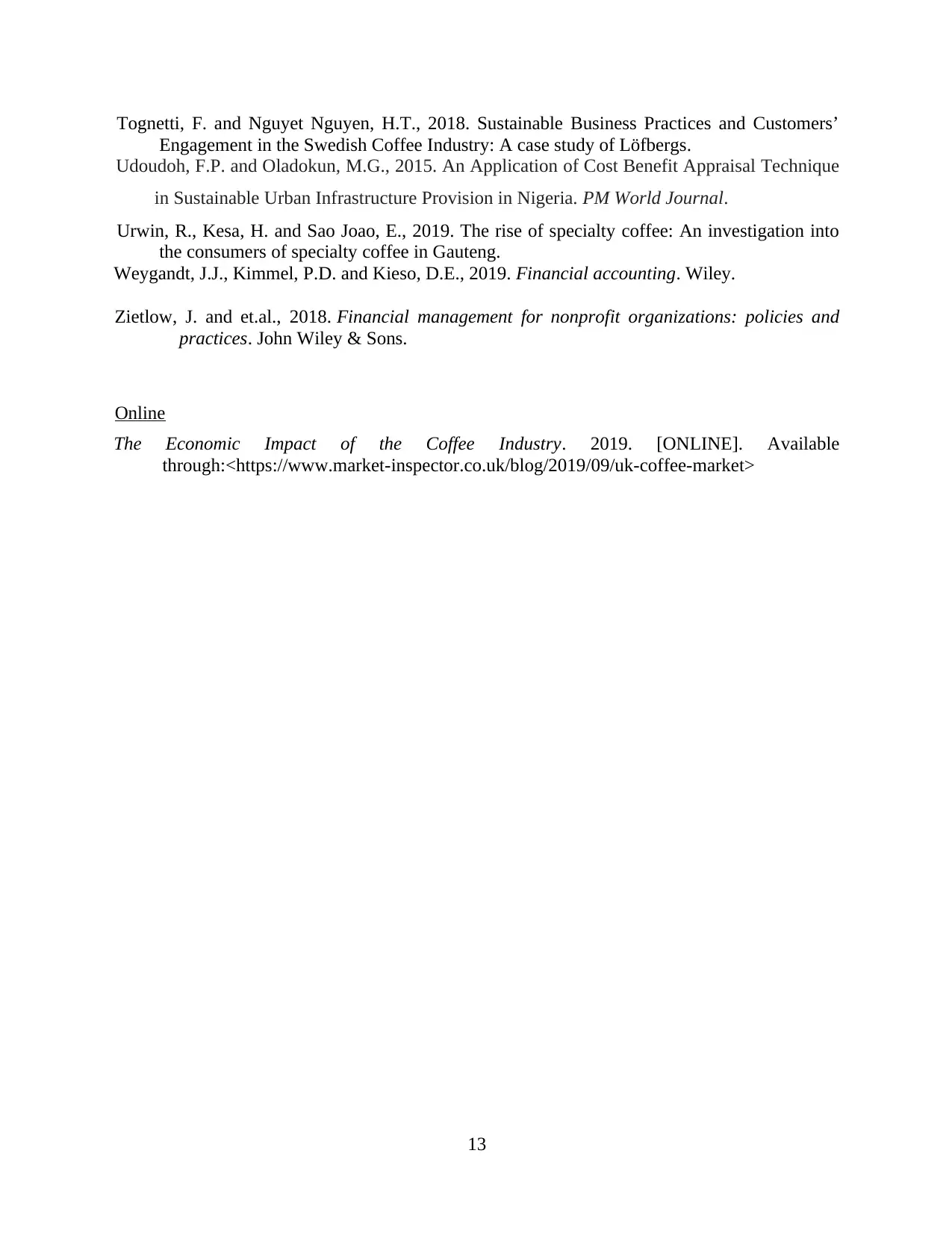
Tognetti, F. and Nguyet Nguyen, H.T., 2018. Sustainable Business Practices and Customers’
Engagement in the Swedish Coffee Industry: A case study of Löfbergs.
Udoudoh, F.P. and Oladokun, M.G., 2015. An Application of Cost Benefit Appraisal Technique
in Sustainable Urban Infrastructure Provision in Nigeria. PM World Journal.
Urwin, R., Kesa, H. and Sao Joao, E., 2019. The rise of specialty coffee: An investigation into
the consumers of specialty coffee in Gauteng.
Weygandt, J.J., Kimmel, P.D. and Kieso, D.E., 2019. Financial accounting. Wiley.
Zietlow, J. and et.al., 2018. Financial management for nonprofit organizations: policies and
practices. John Wiley & Sons.
Online
The Economic Impact of the Coffee Industry. 2019. [ONLINE]. Available
through:<https://www.market-inspector.co.uk/blog/2019/09/uk-coffee-market>
13
Engagement in the Swedish Coffee Industry: A case study of Löfbergs.
Udoudoh, F.P. and Oladokun, M.G., 2015. An Application of Cost Benefit Appraisal Technique
in Sustainable Urban Infrastructure Provision in Nigeria. PM World Journal.
Urwin, R., Kesa, H. and Sao Joao, E., 2019. The rise of specialty coffee: An investigation into
the consumers of specialty coffee in Gauteng.
Weygandt, J.J., Kimmel, P.D. and Kieso, D.E., 2019. Financial accounting. Wiley.
Zietlow, J. and et.al., 2018. Financial management for nonprofit organizations: policies and
practices. John Wiley & Sons.
Online
The Economic Impact of the Coffee Industry. 2019. [ONLINE]. Available
through:<https://www.market-inspector.co.uk/blog/2019/09/uk-coffee-market>
13
1 out of 15
Related Documents
Your All-in-One AI-Powered Toolkit for Academic Success.
+13062052269
info@desklib.com
Available 24*7 on WhatsApp / Email
![[object Object]](/_next/static/media/star-bottom.7253800d.svg)
Unlock your academic potential
© 2024 | Zucol Services PVT LTD | All rights reserved.





